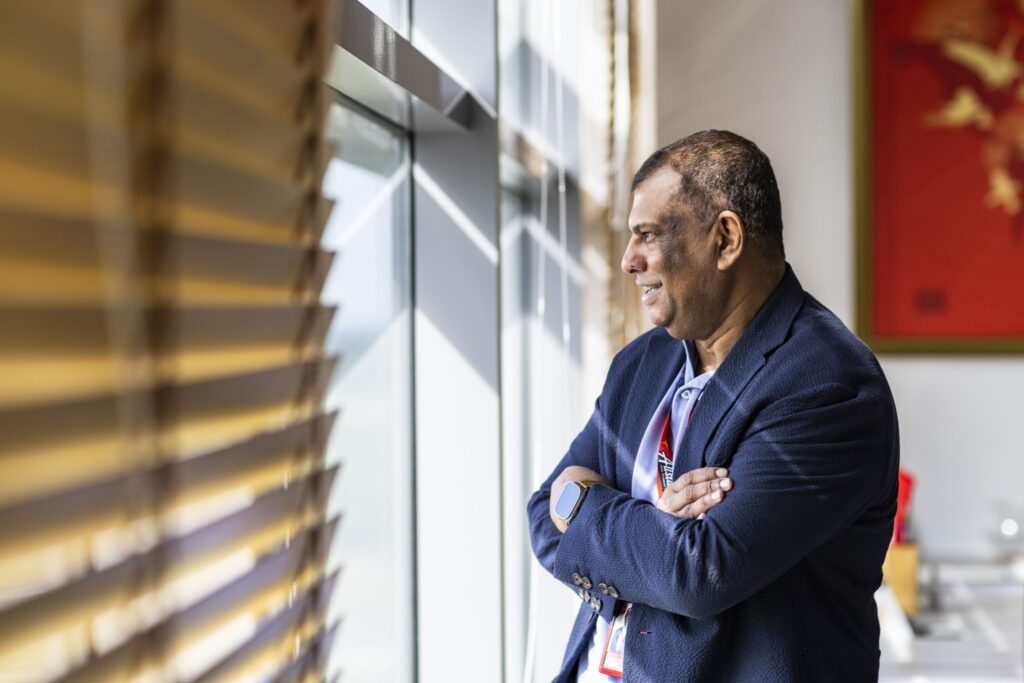 Malaysia-based AirAsia founder Tony Fernandes remains bullish on air travel. MUST CREDIT: Richard Humphries/Bloomberg
Malaysia-based AirAsia founder Tony Fernandes remains bullish on air travel. MUST CREDIT: Richard Humphries/BloombergAviation in a ‘purple patch’ amid new plane crunch, AirAsia says
 Malaysia-based AirAsia founder Tony Fernandes remains bullish on air travel. MUST CREDIT: Richard Humphries/Bloomberg
Malaysia-based AirAsia founder Tony Fernandes remains bullish on air travel. MUST CREDIT: Richard Humphries/BloombergWalmart’s PhonePe launches India mobile app store to rival Google
 A general store advertises the use of the PhonePe digital payment system in Mumbai, India. MUST CREDIT: Dhiraj Singh/Bloomberg
A general store advertises the use of the PhonePe digital payment system in Mumbai, India. MUST CREDIT: Dhiraj Singh/BloombergThe future of work: Why we need to think beyond the hype of the four-day week

Is reducing working hours a sign of progress? Since the 19th century, the number of hours spent at work has been steadily declining in developed countries.
The four-day week emerged in the 90s as a political and economic demand for a more equal division of work. The idea was to reduce the number of hours worked so that more people can access employment. This approach, developed in 1993 by French economist Pierre Larrouturou, was tested in 1996 with the de Robien law on the organisation of working hours. In France, business leaders such as Antoine Riboud, CEO of the multinational food-products firm Danone, championed the idea as a way of boosting recruitment. However, the law was repealed in the early 2000s with the labour reform that introduced the 35-hour week. Elsewhere, in Germany, Volkswagen adopted the four-day week in 1994 to save 30,000 jobs, only to abandon it in 2006.
The Covid crisis and its associated lockdowns have brought this debate back into the spotlight. The widespread adoption of working from home, the use of new technologies and the increase in flexibility have profoundly transformed the way we work. This period has also reinforced employees’ desire for a better work-life balance. As a result, 56% of British employees would accept to earn less money in exchange for more free time.
Against this backdrop, the debate on the four-day week is resurfacing. Countries in Asia and Oceania are looking at ways to organise their workforces in order to reengage their employees. In New Zealand, the government introduced a four-day week at the end of the pandemic to boost productivity and improve work-life balance. In Japan, several companies have also come on board, including Hitachi and Microsoft. This measure, presented as a means of combating overwork culture, is also an opportunity to significantly improve productivity (by 40% in the case of Microsoft).
Europe is following suit, starting with the countries of Northern Europe, followed by the UK, Germany, Spain, Portugal and France.
This reform can take various shapes – each of them presenting specific challenges.
A four-day week or a week squeezed into four days?
The first approach is the most popular: an unchanged number of working hours, concentrated over four days. This is the model implemented by Belgium and the Nordic countries. In autumn 2022, Belgium passed a law on the four-day week, called the “deal for employment”: employees can work four days without any reduction in salary because their weekly working time remains the same. In Italy, the Intesa Sanpaolo bank is doing the same. In France, an attempt to do so was proposed in March 2023 to the employees of Urssaf Picardie, but was a complete failure. The cause: parenthood. Long days no longer allow parents to take their children to and from school.
This is a new form of temporal flexibility, without any reduction in working hours. As economist Éric Heyer points out:
“We shouldn’t confuse the ‘four-day’ week, which reduces working time, with the ‘week in four days’, which compresses it.”
The challenge, then, is to work differently so that the quality of work does not suffer as a result of intensification.
Working less, working better
The second approach is the true ideal of the four-day week, namely the 32-hour week: shorter working hours thanks to increased productivity. It has been implemented in Southern Europe (Spain, Portugal).
This formula is based on the idea of maintaining work productivity by identifying and reducing unproductive time, streamlining certain processes, notably reporting and participation in meetings. Working less, yes, but above all working better. It would in fact limit everything considered superfluous. That said, putting the organisation on a diet reduces its ability to adapt to rapid changes in its environment. For example, we now know that “down times” facilitate the exchange of information between teams.
This approach is deeply embedded in the idea that technology will compensate for any loss of productivity, a recurring theme since the publication of The End of Work in 1995 by American essayist Jeremy Rifkin. The arrival of generative artificial intelligence has brought the concept back to the forefront. Bill Gates even talks about the imminent arrival of the three-day week.
Since the advent of the industrial world, organisations have constantly sought to optimise working time. For many years, it simply kept pace with the production line. Working time and time at work were perfectly synonymous. Today, we don’t have to go to the office to work: work has moved into our personal spaces. Working time has become detached from office time. With the four-day week, the aim is to frame work in terms of time rather than space. Sarah Proust, an expert associated with the Fondation Jean-Jaurès, explains:
“What is at issue here is the organisation and distribution of work, rather the place we intend to give to work in society.”
Toward a new work paradigm?
Instead of focusing on the volume of hours, shouldn’t we be talking about the very nature of work? In the words of economist Timothée Parrique, we need to stop predicting the future of work with ideas like the four-day week, and start inventing the work of the future.
A growing body of research, notably in the wake of anthropologist David Graeber, is highlighting the loss of meaning at work, the rise of “bullshit jobs” and the “revolt of the top of the class”, to borrow the title of journalist Jean-Laurent Cassely’s book.
Unfortunately, reorganising working hours will not be enough to reengage one’s workforce. Working time is above all a “hygiene factor”, as psychologist Frederick Irving Herzberg explains. It cannot deliver the motivation so hoped-for by managers. It can only temper employee dissatisfaction. As a source of personal fulfilment and satisfaction, highers-up need to activate genuine “motivational factors”, such as by valuing the work accomplished, employees’ autonomy, or making work tasks more interesting.
Perhaps we need to create new utopias of work along the lines of Ecotopia: The Notebooks and Reports of William Weston, Ernest Callenbach’s book (1975) that imagined three West Coast states seceding from the USA to establish a radically ecological way of life. In it, Callenbach imagines a new model of society where people only work 22 hours a week. This utopia depicts economies where a large proportion of the available hours are devoted to social, political, cultural and environmental activities. Ecotopia advocates personal and collective fulfilment before individual success. Businesses are self-managed, public transport is free, education and health are accessible to all, criminal violence is absent, universal income is in force and recycling, sobriety and degrowth are the rule.
Callenbach wanted to give us a glimpse of a world he believed to be better, not only for the environment, but also for the individual balance of each person. As we live longer than ever, and as work occupies less time in our lives, we need to imagine, not a new way of working, but a new way of living.![]()
Yaëlle Amsallem, Doctorante, Assistante de recherche de la Chaire Reinventing Work, ESCP Business School and Emmanuelle Léon, Professeure associée, Directrice scientifique de la Chaire Reinventing Work, ESCP Business School
This article is republished from The Conversation under a Creative Commons license. Read the original article.
